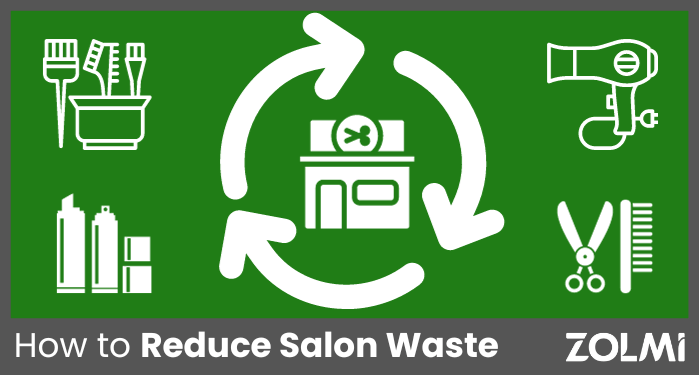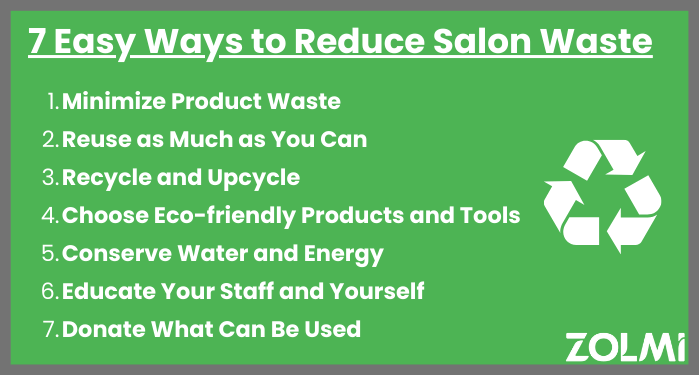How to Reduce Salon Waste in 2024


All across the salon industry, people are trying to reduce salon waste by recycling, reducing the hazardous chemicals they use, and embracing sustainable business practices.
Let’s look at how you can have a more eco-friendly salon.
We’ll go over how to reduce waste in a salon, including how salons can be environmentally friendly by eliminating or cutting down on different types of salon waste and educating staff.
First of all, what types of waste are produced in a salon, and what are the possible environmental issues in the salon and beauty industry?
The beauty industry itself creates more than 421,000 pounds of daily waste, including waste water and packaging that ends up in a landfill. That’s over two million pounds a week.
Hair salon waste statistics don’t need to be this dramatic, if we all do our part for the environment and encourage our staff to adopt more sustainable practices.
Salon waste disposal involves safe handling and having a waste management plan in place for every separate type of recyclable and non recyclable waste in your salon.
Make sure to check your country and state’s environmental health and safety regulations for more specific guidance.
One of your first priorities should be simply reducing the amount of product waste in your salon. This means that you’ll have to get rid of (and buy less) in the long run.
Learning how to minimise product waste in a salon doesn’t have to start with big changes to your business.
It can begin with simple solutions like training a salon's staff on how to reduce product waste in salon appointments by precisely measuring and mixing only what is needed and emptying bottles completely before they dispose of them.
One of my favorite tips on how to reduce cosmetic waste is to use reusable materials when possible and go for products with minimal packaging or buy containers with larger volumes of frequently used items, such as shampoo.
Try to keep a close eye on your inventory and always rotate your stock to keep products from reaching their “use by” dates.
Salon software can help with inventory control and ordering by tracking the slower and faster-moving products and automatically ordering them right before they’re needed. You’ll also be able to view your most popular products, services and busiest times so that you can schedule accordingly and minimize waste while optimizing your salon’s performance.
Cut back on single-use items, using washable cloths instead of paper towels when possible and reusable PPE like plastic face-shields.
You can also offer a refill service for clients that bring back their plastic product containers (this can save you both money and cut down on recyclable waste).
Check your supplier’s website to see if they offer any bulk refillable retail products, as this green alternative is gaining popularity.
All hair salon waste disposal methods should aim to minimize your impact on the environment.
To help create an eco friendly hair salon, start by using proper recycling bins to sort paper, plastic and glass. Some places will even take used foil to be recycled.
Join a recycling program in your area and learn how to prepare things for recycling by checking your city or state’s website.
You can also cut down on what ends up in a landfill by upcycling. This is by far one of my favorite fun and creative ways to reduce waste in the salon. Try taking items that are meant for disposal or recycling and giving them a second life in your hair salon.
Wooden pallets can be sanded and repurposed into free furniture or paneling, and glass jars can become plant or candle holders. You can even shop at the local thrift stores for unique items that you can repaint as future salon furniture.
Select products and tools that can be repaired, recycled, composted or reused.
Electronics are a great example of this- some can only be fixed by the manufacturer, but before replacing them, check the repair cost.
Try to choose plastic containers that are either refillable or recyclable and make sure that any natural material (like single use compostable paper towels) gets composted whenever possible.
What can be recycled in a hairdressing salon depends a lot on your local recycling laws for businesses (which are often different from those for residences), so make sure to do your research when choosing these items.
How much water does the average salon use? The answer is: a lot. Beauty salons use about 270 gallons per chair each day.
For an eco hair salon, switch to high efficiency faucets, showerheads and toilets to keep water-consumption green. Low-flow showerheads at your shampoo stations alone can save you 330 litres of water a day.
Reduce the amount of energy and electricity you consume by switching your lighting to LED bulbs. Consider getting an energy efficient water heater to save even more electricity and take advantage of renewable energy sources like solar panels if they’re available in your area.
Do not miss our post on hair salon plumbing requirements.

Lead by example by learning about the ways to cut waste and regularly updating yourself on any new environmentally-friendly materials and services. Teach your staff about hair salon recycling and stress the importance of working together to save energy.
Ask for their ideas and brainstorm strategies for saving energy and producing less waste together.
It’s important to understand how to dispose of chemical waste in a salon. Even a sustainable hair salon will still have to deal with some chemical waste.
The EPA collects millions in fines every year from businesses that don’t take care of their waste properly. Depending on what the SDS (Safety Data Sheet) for each product says, it may or may not need to be separated and treated as hazardous waste.
Some examples of this include chemicals like acetone, batteries and certain types of nail glue or bleach, which you cannot throw away. Do not bag these up- store them separately in an area with good ventilation and recycle or get rid of them according to state and local regulations.
In particular, 2 types of salon waste that you need to be aware of are clinical and non-clinical. The first one is anything that involves bodily matter taken from clients during services (such as waxing strips, cotton pads, etc.). The second one is everything else.
Depending on what services you offer, you may or may not produce clinical waste. Salons should make sure their staff are properly trained in health and safety and have seperate, marked bins where these items are disposed of.
Keep the health and safety data for all your products handy and make sure that your staff knows the proper way to safely clean up and dispose of any spills.
Do not miss our post on green circle salons.
From hair to unused or unsold products, many items can be donated rather than thrown away.
If you have slow-moving products that are close to their best before date, try creating client interest in them by giving them away while they’re still good. You can either pack them up as samples or offer them as promotional “free gifts” with services or purchases.
Many countries have hair-donation programs that accept longer, unprocessed hair. Donated hair has even been repurposed by some companies into stuffing for emergency pet beds following disasters.
How do salons dispose of waste in a world where we’re creating more than twenty times more plastic than we did half a century ago? And what do we do about all the non-recyclable trash that we create?
The best solution to reduce salon waste is to avoid creating it, whenever possible. Start by switching to larger containers for styling products that you use, joining a recycling program and training your staff in eco-friendly practices. Even small changes add up over time.
The economics of waste
https://www.taylorfrancis.com/books/mono
The concept of waste and waste Management
https://heinonline.org/hol-cgi-bin/get_pdf.cgi?hand
Sustainable waste management systems
https://www.sciencedirect.com/science/article/pii/S095